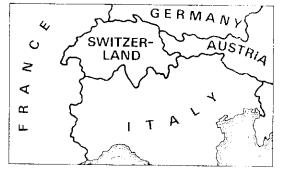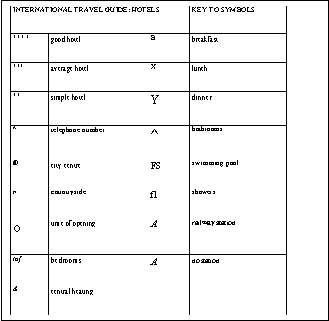For this type of activity the students are given a model text of some kind and
are asked to write a similar text with the help of cues. These may be verbal as in the first example below or visual as in the second. The text may recycle items of spoken or written language and can be used as an introduction to organising ideas in the form of a paragraph.
The concept of parallel writing suggests that the student should have a model from which to work. In other words students will first see a piece of writing and then
use it as a basis for their own work. The original piece that they look at will show them how English is written and guide them towards their own ability to express themselves in written English.
Various ways of reinforcing language learned orally in the early stages are
suggested below:
(a) Writing parallel dialogues with the help of keywords
Read this dialogue:
|
a:
Give me that book, please. b:
Which one? a:
The big one — on the table. b:
Here you are! a:
Thanks very much. |
Now use these keywords to write similar dialogues: (a) umbrella/red/behind/armchair (b) box/small/on top of/cupboard (c) hammer/heavy/near/window, etc. |
More examples of parallel writing:
Example 1) Read about Switzerland:

Switzerland is in Europe. It stands between Germany in the north, Austria in the east, Italy in the south and France in the west. About 5½ million people live in Switzerland and they speak French, German and
Italian. |
g)
Now write about Austria. Use these notes: North: Germany and Czech Republic / east: Slovakia, Hungary / south: Slovenia and Italy / west: Switzerland / 7 million / German |
Example 2: Hotels:
With this stimulating material students have to write descriptions of hotels based on a guide book after first seeing how the symbols are used in a written model. The teacher starts by getting the students to look at the 'Key to symbols' either singly or in pairs. He then finds out if there is any vocabulary the students do not understand. When he is confident that the students understand all the symbols he asks them to study the entry for the Hotel Concorde. He will then ask them comprehension questions to check they have understood the text. If he feels it is necessary he can then elicit similar sentences about, for example, the Castille Hotel as a further check that they can apply the symbols to the model. Students are then asked to write either singly, or in pairs or groups) a similar paragraph about one of the other hotels.

|
It means: The Hotel Concorde in Paris is a good hotel. The telephone number is 88-66-21. It is in the city centre. The hotel is open all year and there are forty bedrooms. There is central heating in the hotel. Breakfast is from seven to nine, lunch is from eleven to three, and dinner is from eight until eleven. There are twenty-five bathrooms and fifteen showers. There is also a swimming pool in the hotel. The nearest railway station is two kilometres away. Now read these symbols, and describe the hotels in the same way. Now read these symbols, and describe the hotels in the same way. |
|
| 1/5 Text 1 | 1/5 Text 2 |
| I like our school. I am in 1b. We do not wear school uniforms. I like wearing my blue jeans, my red T-shirt and my red and green sweater to school. | Our school is OK. I am in 1 a. I think school uniforms look nice, but in our school we do not wear school uniforms. I like wearing jeans and trainers to school. I do not like wearing skirts. |
| 1/20 Text 1 | 1/20 Text 2 |
| I have a friend, her name is Priscilla Hocus-pocus. She is a magician and she lives in an old tree. I like Priscilla very much. She sometimes turns me into a fish. That's great. I like swimming. |
I know a magician. He lives in an old house behind the mountains. He is my best friend. His name is Sylvester Wizz. Sylvester Wizz is a great magician. In his house he has got a big old cupboard. There is a blue, a pink and a yellow bottle in it. When you drink from the blue bottle, you turn into a bird. When you drink from the pink bottle, you turn into an elephant. And when you drink from the yellow bottle, you turn into a crocodile. The yellow bottle is my favourite. |
| 2 / 1 Text 1 | 2/1 Text 2 |
| I stayed at home in the holidays. I played with my friends and I read a lot. I watched a lot of TV too. In the evenings, I sometimes played cards with my mother. | For our holidays, we went to Canterbury, England. My mother has friends there. We went to London by plane. Then we went to Canterbury by train. My mother's friends have a nice house there with a big garden. I often played table tennis in the garden with some English children. That was great fun. |
| 3/6 Text 1 | 3/6 Text 2 |
| I don't care about clothes very much. I think it's stupid to buy expensive clothes. I've got plenty of T-shirts, trainers and sweaters. Why should I buy more? It doesn't matter what you wear. It is important to feel OK in your clothes. I feel best in jeans and T-shirts. | I sometimes envy Thomas. He always wears the latest fashion: T-shirts, trainers, sweaters, trousers, jeans. And all them are new. I usually wear hand-me-downs from my brother. I hate wearing hand-me-downs. With my first money I make, I'll buy lots of clothes. I think clothes are important. |
The following example is taken from: Creative Grammar Practice by G. Gerngroß and Herbert Puchta
I'D LIKE TO BE
Lead-in activities
Noun study
1. Hand out a copy of the following words to each of your students and allow them fifteen seconds to study it.
|
butterfly |
snowman |
rainbow |
snowflake |
|
sports car |
helicopter |
pizza |
pilot |
|
teacher |
tiger |
elephant |
piano |
|
diamond ring |
wind |
Eagle |
mineral |
|
knife |
friend |
flower |
insect |
|
policeman |
river |
pudding |
ice cream |
|
snake |
leaf |
fairy |
witch |
|
word |
ball |
tennis racket |
storybook |
|
shark |
rainbow |
surfboard |
cheesecake |
2. Ask them to put their papers face down on their desks.
1. In pairs students write down as many of the words as they can remember. Allow about two
minutes for this.
2. Ask them to shout out the words. Write them on the board.
Associations and dissociations
1. Ask each pair to choose one noun from the list and note down at least three adjectives that they
associate with it plus at least one adjective they think has nothing at all to do with it. Give a few examples:
ball: red, big, lovely (associations) /stupid (disassociation)
2. Ask pairs to read out their words. Note them on the board in two different colours.
Comparatives and superlatives
1. Next comes a quick response exercise. One student starts by calling out a classmate's name and one of the adjectives from the board.
2. The student called has to quickly say the comparative and the superlative. If right, erase that adjective from the board. If not, leave it until someone else gets both the comparative and superlative correct.
3. Continue until all the adjectives on the board have been erased.
Presentation of model text
Display the following on OHP or poster paper.
MODELTEXT
The most colourful butterfly
The sweetest cheesecake
The most beautiful tiger
The smallest snowflake
The fattest caterpillar
and the most dangerous snowman.
These are what I would like to be.
Text creation
Students write their own texts using bilingual dictionaries.
The following text was written by a twelve-year-old in her second year of learning English.
The most expensive ring,
the softest teddy bear,
the nicest rainbow,
the most colourful surfboard,
the biggest pizza
and the nicest teacher.
These are what I would like to be.